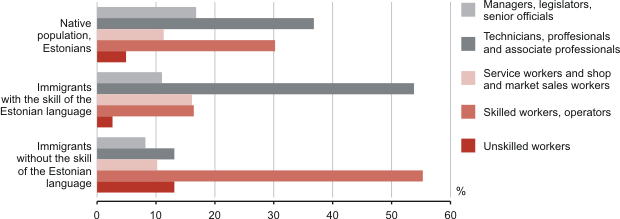Immigrants with the command of the Estonian language are more successful on the labour market
In spite of the rapid changes on the labour market recently, which have been mainly expressed through the growth of unemployment big differences of occupational division remained comparing immigrants with and without the Estonian language skill.
The comparison of native Estonians and Estonian-speaking immigrants indicates that there are some differences between the distribution of occupations in the groups, but they do not amount to a confirmation of occupational division. However, signs of division can be detected in the distribution of occupations among immigrants with the skill of the Estonian language and immigrants without the skill of the Estonian language. More than a half of immigrants without the skill of the Estonian language were employed as skilled workers or operators. The share of unskilled workers was also rather high in this group (13%). The share of persons employed as managers, specialists of different levels or officials was 21%.
The group of employed native Estonians and immigrants with the skill of the Estonian language included the highest number of top specialists, mid-level specialists and officials. These occupation categories were also dominant among the immigrants with the skill of the Estonian language — top specialists, mid-level specialists and officials even accounted for more than a half of the employed persons in this group (54%), this indicator was even larger than that among the native Estonians (37%). The percentage of managers, senior officials or legislators was the highest among the native population of the Estonian nationality — 17%. Among immigrants with the skill of the Estonian language there were 11% of managers, senior officials or legislators. Another characteristic in the distribution of occupations among native Estonians and immigrants with the skill of the Estonian language was the relatively small percentage of unskilled workers (less than 5%).
The Immigrant Population Survey was conducted by Statistics Estonia for the first time in 2008. Immigrant population has been defined as the people living in Estonia whose parents were born in a foreign state. In addition, if only one non-Estonian-born parent is known, the respondent is considered as a part of immigrant population. In 2008, the share of immigrant population among the permanent residents of Estonia was 24%. Native Estonians are the residents of the Estonian ethnic nationality whose both or one parent was born in Estonia.
Occupations of native and immigrant population aged 25–49 by the background and the skill of the Estonian language, 2008

A more detailed analysis was published today, on 28 September in the publication “Immigrantrahvastik Eestis. 2009. Immigrant Population in Estonia” /uudised/31389
The analytical publication provides an overview of immigrant population in Estonia and compares it with the native population. The major part of the analysis includes immigrants on the labour market — employment, income, wages and salaries, occupational structure and its relation to the educational level. Job changes and the description of the job searching as well as the indicators characterising the integration process have also been discussed. Integration and immigrants’ connections to the country where immigrants’ parents were born have been analysed as well.